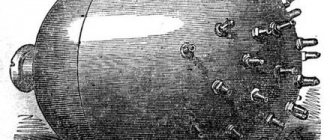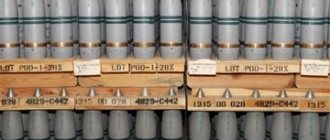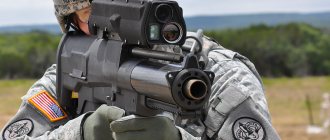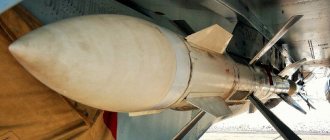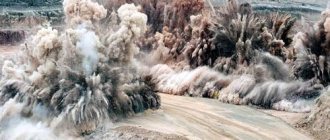MAIN TYPES OF WEAPONS AND THEIR DAMAGING FACTORS
Conventional weapons (CW) are a complex of small arms, artillery, engineering, naval, missile and aviation weapons or ammunition that use the energy of impact and explosion of explosives and their mixtures.
Conventional weapons are classified according to the method of delivery, caliber, type of warheads, and the principle of action on obstacles.
The most common conventional ammunition that can be used for attacks on cities and towns can be fragmentation bombs, high-explosive bombs, ball bombs, volumetric explosion ammunition, and incendiary weapons. Let's get acquainted with some types of conventional weapon ammunition and their damaging factors.
Fragmentation bombs are used to kill people and animals. When a bomb explodes, a large number of fragments are formed, which fly in different directions at a distance of up to 300 m from the explosion site. Splinters do not penetrate brick and wooden walls.
High-explosive bombs are designed to destroy all kinds of structures. Compared to nuclear weapons, their destructive power is small. Unexploded aerial bombs pose a great danger. Most often they have delayed fuses that go off automatically some time after the bomb is dropped.
Ball aerial bombs are equipped with a huge number (from several hundred to several thousand) of fragments (balls, needles, arrows, etc.) weighing up to several grams. Ball bombs, ranging in size from a tennis ball to a soccer ball, can contain 300 metal or plastic balls with a diameter of 5-6 mm. The radius of the bomb's destructive effect is up to 15 m.
Volumetric explosion ammunition is dropped from the aircraft in the form of cassettes. The cartridge contains three rounds of ammunition each containing approximately 35 kg of liquid ethylene oxide. Ammunition is separated in the air. When they hit the ground, a fuse is triggered, which ensures the dispersion of liquid and the formation of a gas cloud with a diameter of 15 m and a height of 2.5 m. This cloud is undermined by a special delayed-action device.
The main damaging factor of volumetric explosion ammunition is a shock wave propagating at supersonic speed, the power of which is 4-6 times higher than the explosion energy of a conventional explosive.
Incendiary weapons, depending on their composition, are divided into: incendiary mixtures based on petroleum products (napalm), metallized incendiary mixtures, thermite compounds, white phosphorus.
The means of using incendiary weapons can be aerial bombs, cassettes, artillery incendiary ammunition, flamethrowers, etc.
The thermal effect of incendiary weapons on the human body leads primarily to burns.
Incendiaries used in the form of aerial bombs pose a serious danger to people. When they get on exposed skin or clothing, they cause very severe burns and burnouts. During the combustion of these products, the air quickly heats up, which leads to burns of the respiratory tract. The use of incendiary agents causes massive fires.
Mines are one of the most insidious types of weapons. They cause untold suffering to civilians long after the fighting has ended. The exact number of mines left after wars and armed conflicts on the territory of more than 70 countries is unknown, but even according to approximate data from the International Committee of the Red Cross and the UN Department of Mine Action, it is currently expressed at 100 million. Millions of them have not yet been cleared and are still waiting for their victims in different parts of the planet; Every year, mines claim more than 25,000 innocent lives. Every week around the globe, about 500 people are killed or disabled as a result of mine explosions, in other words, every 20 minutes, someone is killed or maimed by mines.
Nuclear weapons are a type of explosive mass destruction weapon based on the use of intranuclear energy released during chain reactions of fission of heavy nuclei of some isotopes of uranium and plutonium or during fusion reactions of light nuclei such as deuterium, tritium (hydrogen isotopes) and lithium.
Nuclear weapons include: various nuclear weapons; means of their delivery to the target (carriers); controls. Nuclear munitions include nuclear warheads of missiles and torpedoes, nuclear bombs, artillery shells, depth charges, and mines (land mines). Carriers of nuclear weapons are considered to be aircraft, surface ships and submarines equipped with nuclear weapons and delivering them to the launch (firing) site. There are also carriers of nuclear charges (missiles, torpedoes, shells, aircraft and depth charges), which deliver them directly to targets. They can be launched (shot) from stationary installations or from moving objects. (A nuclear charge is a component of a nuclear weapon.).
Damaging factors of a nuclear explosion:
1. The shock wave is the main damaging factor of a nuclear explosion, since most of the destruction and damage to structures, buildings, as well as injuries to people are, as a rule, caused by the impact of the shock wave. It is an area of sharp compression of the medium, spreading in all directions from the explosion site at supersonic speed. The front boundary of the compressed air layer is called the shock wave front. The damaging effect of a shock wave is characterized by the magnitude of excess pressure, i.e., the magnitude of the difference between the maximum pressure in the shock wave front and normal atmospheric pressure.
2. Light radiation is a stream of radiant energy, including visible, ultraviolet and infrared rays. Its source is a luminous area formed by hot explosion products and hot air. Light radiation spreads almost instantly and lasts, depending on the power of the nuclear explosion, up to 20 s. However, its strength is such that, despite its short duration, it can cause burns to the skin (skin), damage (permanent or temporary) to people’s organs of vision and fire of flammable materials and objects.
3. Ionizing radiation (penetrating radiation) is a flow of gamma rays and neutrons. It lasts 10-15 s. Passing through living tissue, gamma radiation and neutrons ionize the molecules that make up the cells. Under the influence of ionization, changes in biological processes occur in the body, leading to disruption of the vital functions of the body.
4. Radioactive contamination is the result of the fallout of radioactive substances from the cloud of a nuclear explosion, both in the area of the explosion and far beyond it, at a distance of several hundred and even thousands of kilometers. Radioactive substances are a source of radiation harmful to living organisms. Radioactive damage resulting from external irradiation and the entry of radioactive substances into the body causes radiation sickness.
5. An electromagnetic pulse arises as a result of the interaction of radiation emanating from the zone of a nuclear explosion with atoms of the environment. As a result, short-term electric and magnetic fields arise in the air, which constitute an electromagnetic pulse. As a result of its impact, wire and cable lines and radio equipment are damaged.
Chemical weapons are weapons of mass destruction, the action of which is based on the toxic properties of chemicals.
Chemical weapons include toxic substances (CAS) and means of their use. Missiles, aircraft bombs, and artillery shells are equipped with toxic substances.
Based on their effect on the human body, agents are divided into nerve agents, blister agents, asphyxiating agents, general toxic agents, irritants and psychochemical agents.
Bacteriological (biological) weapons are a type of weapon of mass destruction, the action of which is based on the use of the pathogenic properties of microorganisms and their metabolic products.
Bacteriological (biological) weapons (BW) are special ammunition and combat devices with delivery vehicles, equipped with biological agents and intended for mass destruction of enemy personnel, farm animals, and crops. Along with nuclear and chemical weapons, bacteriological weapons are classified as weapons of mass destruction.
The damaging effect of BO is based primarily on the use of the pathogenic properties of microbes and toxic products of their vital activity. The basis of the destructive effect of biological weapons are biological agents, specially selected for combat use and capable of causing massive severe diseases in people, animals, and plants.
Precision-precision weapons (HPE) are a controlled weapon, the effectiveness of which is based on high accuracy of hitting the target.
Precision-precision weapons (HPE) include: combat missiles for various purposes; guided missiles; guided aerial bombs, etc.
With the help of high-tech weapons with conventional, non-nuclear weapons, it is possible to inflict defeats comparable in their consequences to defeat from low-yield tactical nuclear weapons. Further development of the WTO goes in the direction of its “intellectualization, i.e. the ability to recognize targets, including on the battlefield and in jammed conditions, and when targeting large targets, select the most vulnerable element to hit.
What is an explosion?
Each of us has an idea of what it is. If you have never encountered such a phenomenon in real life, then at least you have seen it in movies or on the news.
An explosion is a chemical reaction that occurs at tremendous speed. At the same time, energy is still released and compressed gases are formed, which can have a damaging effect on people.
If safety precautions are not observed or technological processes are violated, emergency situations with explosions may occur at industrial facilities, in buildings, and on communications. Often it is the human factor that causes an explosion.
There is also a special group of substances that are classified as explosive, and under certain conditions they can explode. A distinctive feature of the explosion is its transience. Just a split second is enough for, for example, a room to fly into the air during a gas explosion. In this case, the temperature reaches several tens of thousands of degrees Celsius. The damaging factors of an explosion can cause serious injury to a person; they are capable of exerting their negative influence on people at a certain distance.
Not every such emergency is accompanied by the same destruction; the consequences will depend on the power of the explosive device and the place where it all happens.
Characteristics of light emission
After the explosion, a light energy flux is formed, which consists of the ultraviolet, visible and infrared spectrum. Light is emitted by parts of ammunition that have heated to high temperatures. The maximum temperature can exceed 7 thousand degrees.
Light radiation can have the following damaging effects:
- Burns.
- Eye damage.
- Ignition of materials and objects.
- Fires.
The degree of impact may vary:
- There are areas in which individual fires occur.
- In areas of severe destruction, as a rule, up to 90% of buildings burn. This is the most dangerous zone.
- They also identify a zone of fires in the rubble, where everything has already evaporated and collapsed, leaving only smoldering.
Nuclear explosion zones
To determine the nature of possible destruction and the scope of rescue operations, the source of nuclear damage is divided into several zones:
- An area of complete destruction. Here you can see 100% loss among the population if it was not protected. The main damaging factors of the explosion have their maximum impact. You can see the almost complete destruction of buildings, damage to utility networks, and the complete destruction of forests.
- The second zone is the area where severe destruction is observed. Losses among the population reach 90%. Most of the buildings are destroyed, and solid rubble forms on the ground, but shelters and anti-radiation shelters manage to survive.
- Zone with moderate damage. Losses among the population are small, but there are many wounded and injured. There is partial or complete destruction of buildings, and rubble is formed. It is quite possible to escape in shelters.
- Zone of weak destruction. Here the damaging factors of the explosion have minimal impact. The destruction is insignificant, there are practically no casualties among people.
Types of damage from explosions
Depending on the proximity of the explosion, a person may receive injuries of varying severity:
- Lungs. This may include a minor concussion, partial hearing loss, and bruises. Hospitalization may not even be required.
- Average. This is already a brain injury with loss of consciousness, bleeding from the ears and nose, fractures and dislocations.
- Severe damage includes severe contusion, damage to internal organs, complicated fractures, and sometimes death is possible.
- Extremely severe. In almost 100% of cases it ends in the death of the victim.
We can give the following example: when a building is completely destroyed, almost everyone who was there at that moment dies; only a happy accident can save a person’s life. And with partial destruction, there may be deaths, but most will receive injuries of varying degrees of severity.
Penetrating radiation
When an explosion occurs, there is a stream of neutrons and gamma rays - this is penetrating radiation. Neutrons pass freely through living tissues and disrupt the functioning of cells, metabolic processes, and negatively affect the functioning of organs and systems. All this ends with the development of radiation sickness. Its most severe forms are fatal.
The most dangerous zone is a radius of 2-3 kilometers from the source of the explosion. In addition to having a negative impact on living organisms, radiation can damage optical and electronic devices.
In order to somehow weaken the destructive effect of penetrating radiation, it is necessary to use protective materials, which we will discuss later.
Affected areas
The damaging factors of an explosion can cause damage to a person of varying degrees of severity. Experts identify several zones:
- Zone I.
- Zone II.
- Zone III.
In the first two, the consequences are the most severe: charring of bodies occurs under the influence of very high temperatures and explosion products.
In the third zone, in addition to the direct influence of explosion factors, indirect influence can also be observed. The impact of a shock wave is perceived by a person as a strong blow, which can damage:
- internal organs;
- hearing organs (ruptured eardrum);
- brain (concussion);
- bones and tissues (fractures, various injuries).
The most difficult situation is for people who encountered a shock wave in a standing position outside the shelter. In such a situation, death often occurs or a person receives severe injuries and serious injuries, burns.
Consequences of the explosion
The damaging factors of the explosion are:
- A stream of gaseous substances.
- Heat.
- Light radiation.
- A sharp and loud sound.
- Shards.
- Air shock wave.
Such phenomena can be observed during the explosion of both warheads and household gas. The former are often used for combat operations; they are used only by highly qualified specialists. But there are situations when objects capable of exploding fall into the hands of civilians, and it is especially scary if they are children. In such cases, as a rule, explosions end in tragedy.
Household gas explodes mainly if the rules for its operation are not followed. It is very important to teach children how to use gas appliances and display emergency phone numbers in a visible place.
Nuclear explosion
It is the result of a nuclear warhead. This is an uncontrolled process in which a huge amount of radiant and thermal energy is released. All this is the result of a chain reaction of fission or thermonuclear fusion in a short period of time.
The main distinguishing feature of a nuclear explosion is that it always has a center - the point where exactly the explosion occurred, as well as an epicenter - the projection of this point onto the earth or water surface.
Next, the damaging factors of the explosion and their characteristics will be considered in more detail. Such information should be brought to the attention of the population. As a rule, students receive it at school, and adults at work.
Radioactive contamination
As a result of the explosion, various products and radioactive isotopes are formed. They are the main source of radioactive contamination. If an explosion occurs on the ground, a cloud with radioactive products is formed at a height of many kilometers. It is carried by the wind, particles fall to the ground, and as a result a zone of radioactive contamination is formed.
Everything is exposed to it: soil, water, air, infrastructure. The greatest danger is observed in the first hours after precipitation. Since at this time the activity of all radioactive particles is maximum.
